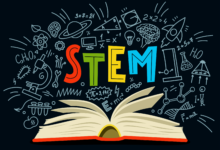The Potential of EdTech in Promoting STEM Education: 6 Important Points

Promoting STEM Education, Education is evolving rapidly in the digital age and is one area that has seen significant advancements in STEM education. Science, Technology, Engineering, and Mathematics (STEM) play a crucial role in driving innovation, economic growth, and solving complex global challenges. To harness the full potential of STEM education, the integration of educational technology, or EdTech, has become increasingly vital. In this article, we will explore the importance of STEM education, the role of EdTech in promoting it, and how it can enhance learning outcomes for students.
STEM education focuses on equipping students with the knowledge and skills necessary for success in the modern world. It nurtures critical thinking, and problem-solving abilities, and fosters a deep understanding of scientific concepts. As technological advancements continue to reshape industries, there is a growing demand for professionals skilled in STEM fields.
Read More: 5 Best Benefits of EdTech for Students in Low-Income Communities
Importance of STEM Education
Advancements in Science, Technology, Engineering, and Mathematics
Promoting STEM Education, STEM fields are at the forefront of innovation and discovery. From breakthroughs in medical research to the development of cutting-edge technologies, STEM disciplines drive progress and shape the future. By promoting STEM education, we ensure a continuous pipeline of talented individuals ready to tackle complex challenges.
Growing Demand for STEM Professionals
The demand for STEM professionals is rapidly increasing across various industries. Jobs in fields such as data science, software engineering, renewable energy, and robotics offer lucrative opportunities for those with STEM expertise. By providing students with a solid foundation in STEM subjects, we empower them to pursue fulfilling careers and contribute to global advancements.

Role of EdTech in STEM Education
Promoting STEM Education, EdTech has revolutionized the learning landscape by providing innovative tools and platforms that enhance the teaching and learning experience. When it comes to STEM education, EdTech plays a pivotal role in making learning more accessible, engaging, and interactive.
Accessible Learning Materials
EdTech platforms offer a wealth of digital resources that can be accessed anytime, anywhere. Students can explore interactive textbooks, video tutorials, and online courses tailored to their learning pace and preferences. This accessibility breaks down barriers and ensures equal opportunities for all learners.
Interactive and Engaging Content
Promoting STEM Education, Traditional teaching methods often struggle to captivate students’ attention. EdTech provides immersive learning experiences through interactive content, such as virtual reality (VR) simulations and augmented reality (AR) applications. These engaging tools make complex concepts easier to comprehend, sparking curiosity and fostering a love for STEM subjects.
Virtual Laboratories and Simulations
Laboratory experiments are an integral part of STEM education, but they can be costly and logistically challenging. EdTech bridges this gap by offering virtual laboratories and simulations. Students can perform experiments in a safe and controlled digital environment, allowing for hands-on learning and deeper understanding of scientific principles.
Enhancing Learning Outcomes with EdTech
Promoting STEM Education, EdTech not only improves accessibility and engagement but also enhances learning outcomes for students in STEM education.
Personalized Learning
Every student has unique learning needs and preferences. EdTech platforms utilize adaptive learning algorithms to tailor content and assessments to individual students. Personalized learning paths ensure that students receive targeted instruction, remediation, or acceleration based on their abilities, resulting in better academic outcomes.

Collaborative Learning
Promoting STEM Education, Collaboration and teamwork are essential skills in STEM fields. EdTech tools facilitate virtual collaboration, allowing students to work together on projects, share ideas, and solve problems remotely. This fosters a sense of community, encourages peer learning, and prepares students for real-world collaborative environments.
Real-World Applications
One common criticism of traditional education is the perceived lack of real-world relevance. EdTech bridges this gap by incorporating real-world applications into STEM learning. Students can explore practical examples, case studies, and industry projects, gaining a deeper understanding of how STEM concepts are applied in professional settings.
Bridging the Gender Gap in STEM
Promoting STEM Education, Gender parity in STEM fields remains a significant challenge. EdTech can play a vital role in bridging the gender gap by creating inclusive learning environments and breaking stereotypes. Through engaging and relatable content, EdTech platforms can inspire more girls to pursue STEM education and careers, ensuring diverse perspectives and a more balanced workforce.
Overcoming Challenges and Concerns
Promoting STEM Education, While EdTech offers immense potential in promoting STEM education, several challenges and concerns must be addressed for successful implementation.
Accessibility and Infrastructure
Equal access to EdTech resources can be a challenge, especially in underserved communities or regions with limited internet connectivity. To ensure inclusivity, efforts should be made to provide adequate infrastructure and training to educators and students.
Teacher Training and Support
For EdTech to be effective, teachers need proper training and support to integrate technology seamlessly into their curriculum. Professional development programs and ongoing support can empower educators to leverage EdTech tools effectively and maximize their impact on student learning.

Data Privacy and Security
Promoting STEM Education, The collection and storage of student data through EdTech platforms raise concerns about privacy and security. It is crucial to establish robust safeguards and comply with data protection regulations to ensure the confidentiality and integrity of student information.
Promoting STEM Education, Conclusion
EdTech has the potential to revolutionize STEM education by making it more accessible, engaging, and effective. By leveraging innovative tools and platforms, students can develop the necessary skills to thrive in STEM fields. However, successful implementation requires addressing challenges, providing necessary infrastructure, and supporting teachers in integrating EdTech seamlessly into the curriculum. With continued advancements in EdTech, we can empower the next generation of STEM professionals and drive innovation to shape a better future.
Read More: 5 Best Roles of EdTech in promoting emotional intelligence
FAQs
How can EdTech support STEM education for students with disabilities?
EdTech provides various accessibility features, such as screen readers, closed captions, and adaptive learning platforms, which can support students with disabilities in STEM education. These tools accommodate diverse learning needs and ensure equal access to educational resources and opportunities.
What are some examples of EdTech tools used in STEM classrooms?
Some popular EdTech tools used in STEM classrooms include coding platforms like Scratch and Tynker, virtual laboratories like Labster and PhET, interactive simulations like ExploreLearning Gizmos, and collaborative platforms like Google Classroom and Microsoft Teams.
Is EdTech suitable for all age groups in STEM education?
EdTech can be adapted to suit different age groups in STEM education. There are age-appropriate platforms and tools available, ranging from interactive games for early learners to advanced programming environments for older students. Customization and flexibility are key to ensuring the suitability of EdTech for different age groups.
How can EdTech promote creativity and innovation in STEM learning?
EdTech can promote creativity and innovation in STEM learning by providing opportunities for hands-on experimentation, problem-solving challenges, and project-based learning. It encourages students to think critically, explore different solutions, and apply their creativity to real-world problems.
What are the potential career opportunities in STEM fields?
STEM fields offer a wide range of career opportunities. Some popular STEM careers include software engineer, data scientist, biomedical researcher, environmental engineer, robotics engineer, and cybersecurity analyst. These fields continue to grow and evolve, providing diverse and rewarding career paths for STEM graduates.












2 Comments